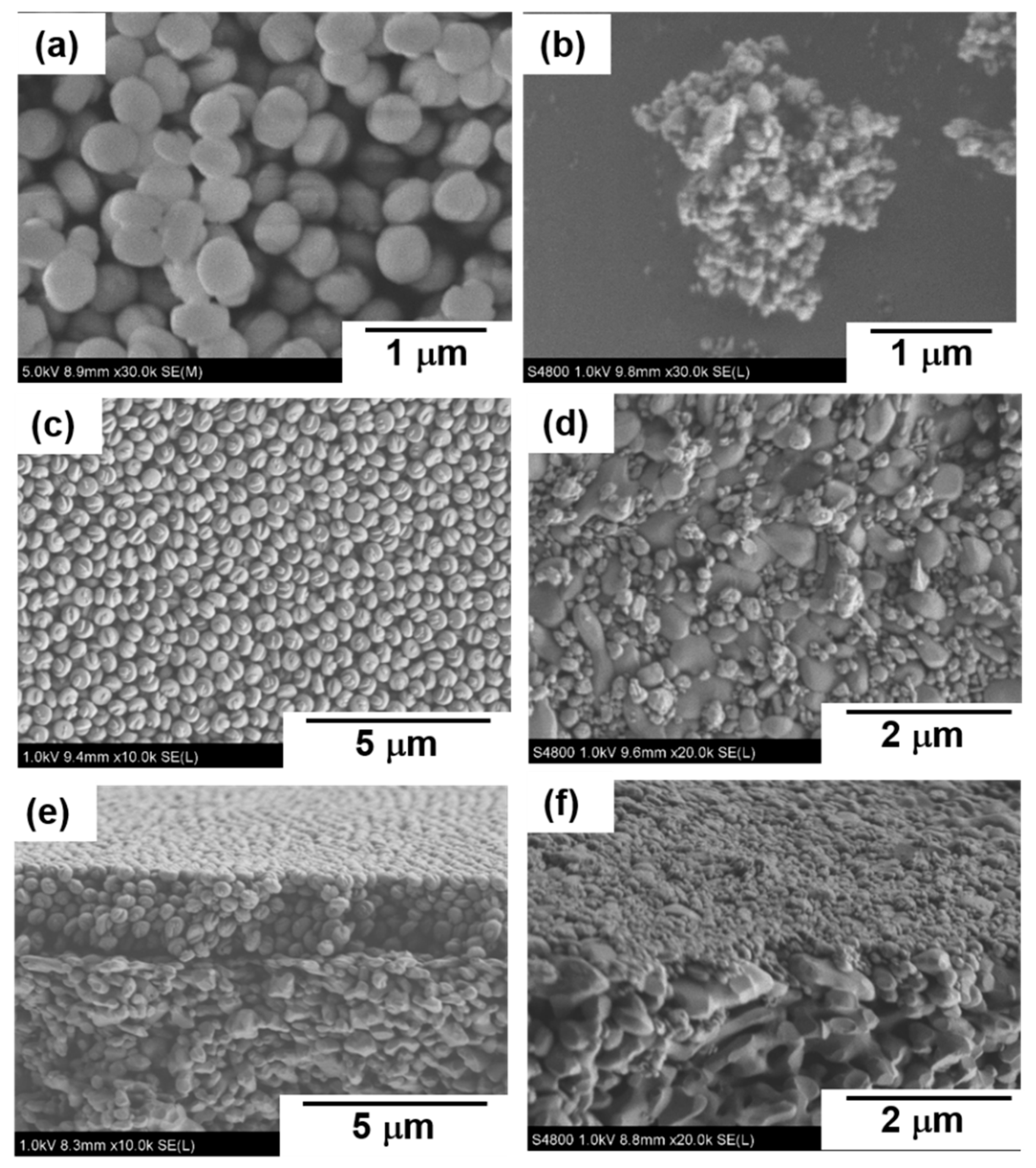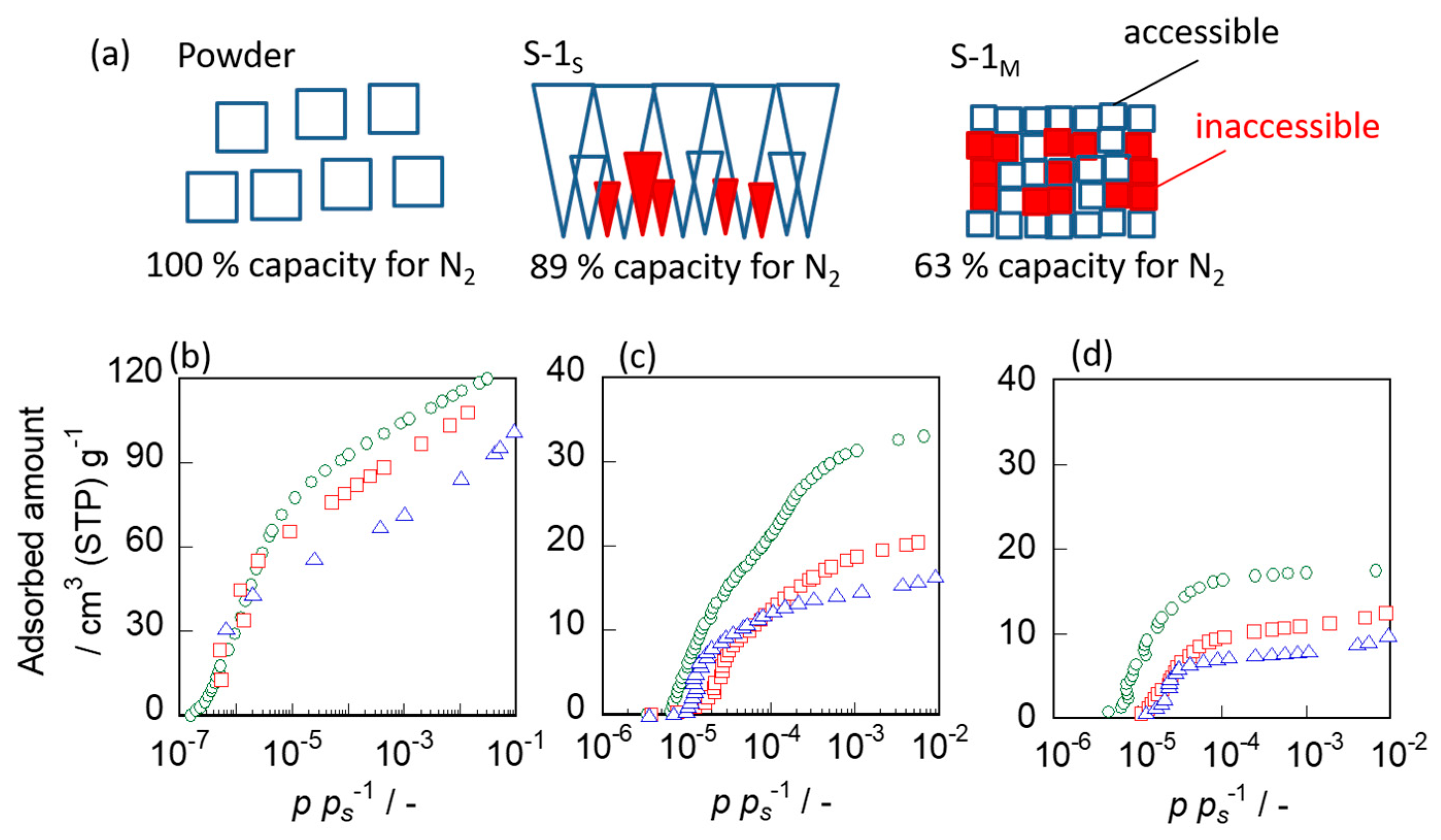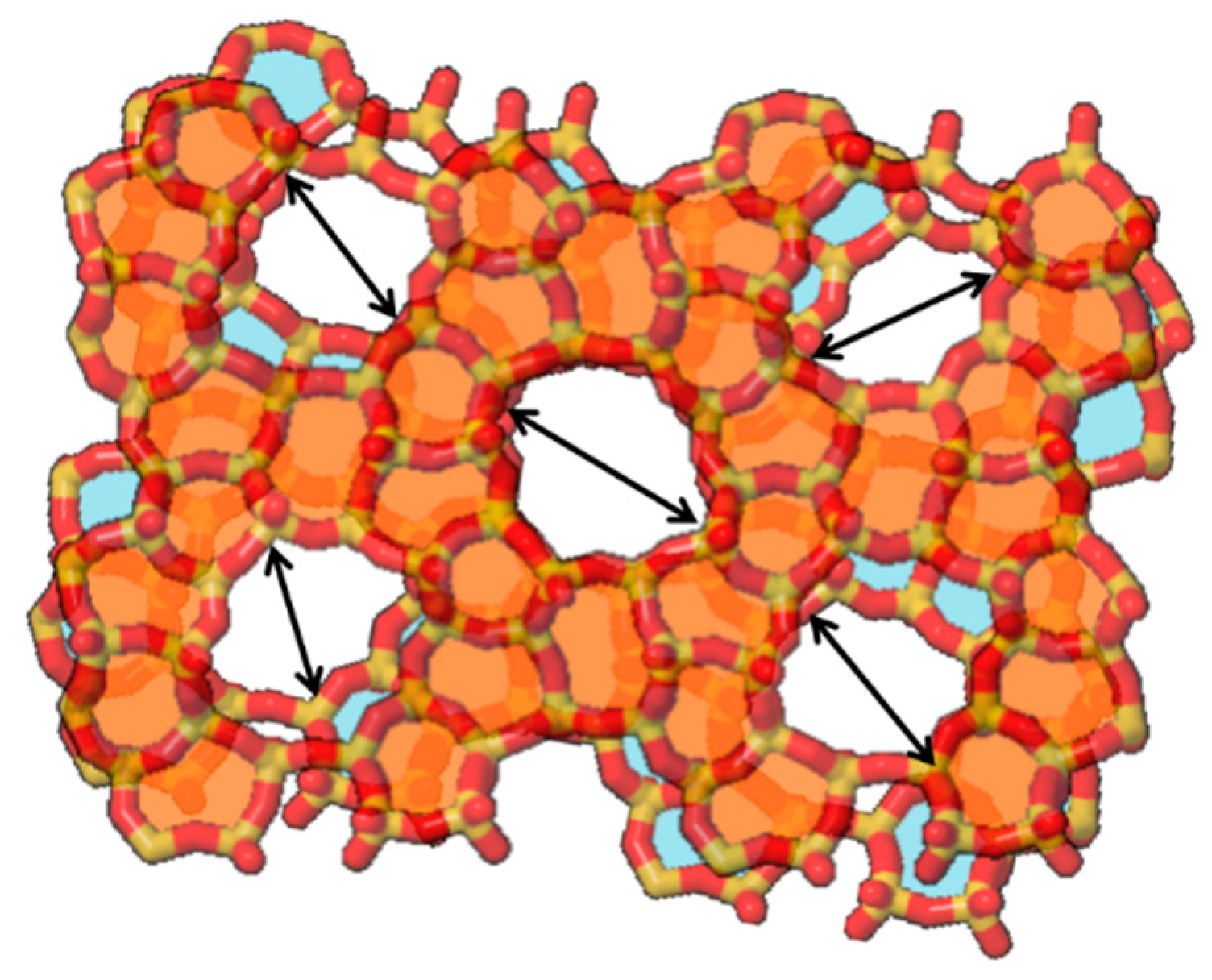Contribution of Pore-Connectivity to Permeation Performance of Silicalite-1 Membrane; Part I, Pore Volume and Effective Pore Size
Abstract
:1. Introduction
2. Materials and Methods
2.1. Procedure of Membrane Preparation
2.2. Nano-Permporometry
2.3. Vapor Permeation Test
2.4. Adsorption Measurement
3. Results
3.1. XRD and Microscopic Observation for Membranes
3.2. Nano-Permporometry
3.3. Adsorption Measurement for Silicalite-1 Powder and Membranes
3.4. Vapor Permeation Tests in Unary Systems
4. Discussion
4.1. Effect of Synthesis Conditions on Crystal Structures and the Appearance of Membranes
4.2. Micropore Volume, Effective Pore Size and the Permeation Property
5. Conclusions
Supplementary Materials
Author Contributions
Funding
Conflicts of Interest
Nomenclature
| A | Effective membrane area [m2] | |
| DK | Kelvin diameter [m] | |
| ν | molar volume [m3 mol−1] | |
| p | Partial pressure [Pa] | |
| pS | Saturated vapor pressure [Pa] | |
| θ | Contact angle [degree] | |
| R | Gas constant [J mol−1 K−1] | |
| σ | Surface tension [N m−1] | |
| T | Temperature [K] | |
| u | Flow rate [mol s−1] | |
References
- Sholl, D.S.; Lively, R.P. Seven Chemical Separations to Change the World. Nature 2016, 532, 435–437. [Google Scholar] [CrossRef]
- Pollitt, K.R.; Robb, J.C.; Thomas, D.W. Structure of synthetic zeolite ZSM-5. Nature 1978, 272, 437–438. [Google Scholar] [CrossRef]
- Olson, D.H.; Kokotallo, G.T.; Lawton, S.L.; Meler, W.M. Crystal structure and structure-related properties of ZSM-5. J. Phys. Chem. 1981, 85, 2238–2243. [Google Scholar] [CrossRef]
- Funke, H.H.; Argo, A.M.; Falconer, J.L.; Noble, R.D. Separation of Cyclic, Branched, and Linear Hydrocarbon mixtures through Silicalite Membranes. Ind. Eng. Chem. Res. 1997, 36, 137–143. [Google Scholar] [CrossRef]
- Keizer, K.; Burggraaf, A.J.; Vroon, Z.A.E.P.; Verweij, H. Two component permeation through thin zeolite MFI membranes. J. Membr. Sci. 1998, 147, 159–172. [Google Scholar] [CrossRef]
- Pan, M.; Lin, Y.S. Template-free secondary growth synthesis of MFI type zeolite membranes. Micropor. Mesopor. Mater. 2001, 43, 319–327. [Google Scholar] [CrossRef]
- Yuan, W.; Lin, Y.S.; Yang, W. Molecular sieving MFI-type zeolite membranes for pervaporation separation of xylene isomers. J. Am. Chem. Soc. 2004, 126, 4776–4777. [Google Scholar] [CrossRef]
- Mabande, G.T.P.; Noack, M.; Avhale, A.; Kolsch, P.; Georgi, G.; Schwieger, W.; Caro, J. Permeation properties of bi-layered Al-ZSM-5/Silicalite-1 membranes. Micropor. Mesopor. Mater. 2007, 98, 55–61. [Google Scholar] [CrossRef]
- Tarditi, A.M.; Lombardo, E.A. Influence of exchanged cations (Na+, Cs+, Sr2+ and Ba2+) on xylene permeation through ZSM-5/SS tubular membranes. Sep. Purif. Technol. 2008, 61, 136–147. [Google Scholar] [CrossRef]
- Zhang, C.; Hong, Z.; Gu, X.; Zhong, Z.; Jin, W.; Xu, N. Silicalite-1 zeolite membrane reactor packed with HZSM-5 catalyst for meta-xylene isomerization. Ind. Eng. Chem. Res. 2009, 48, 4293–4299. [Google Scholar] [CrossRef]
- Daramola, M.O.; Burger, A.J.; Titus, M.P.; Fendler, A.G.; Miachon, S.; Lorenzen, L.; Dalmon, J.-A. Nanocomposite MFI-ceramic hollow fibre membranes via pore-plugging synthesis: Prospects for xylene isomer separation. J. Membr. Sci. 2009, 337, 106–112. [Google Scholar] [CrossRef]
- Wu, A.; Tang, C.; Zhong, S.; Wang, B.; Zhou, J.; Zhou, R. Synthesis optimization of (h0h)-oriented silicalite-1 membranes for butane isomer separation. Sep. Purif. Technol. 2019, 214, 51–60. [Google Scholar] [CrossRef]
- Sun, K.; Liu, B.; Zhong, S.; Wu, A.; Wang, B.; Zhou, R.; Kita, H. Fast preparation of oriented silicalite-1 membranes by microwave heating for butane isomer separation. Sep. Purif. Technol. 2019, 219, 90–99. [Google Scholar] [CrossRef]
- Luo, R.; Ding, H.; Lyu, J.; Fu, T.; Bai, P.; Guo, X.; Tsapatsis, M. Fabrication of a sandwiched silicalite-1 membrane in a 2D confined space for enhanced alcohol/water separation. Chem. Commun. 2020, 56, 12586–12588. [Google Scholar] [CrossRef]
- Ueno, K.; Negishi, H.; Okuno, T.; Tawarayama, H.; Ishikawa, S.; Miyamoto, M.; Uemiya, S.; Oumi, Y. Effects of Silica-Particle Coating on a Silica Support for the Fabrication of High-Performance Silicalite-1 Membranes by Gel-Free Steam-Assisted Conversion. Membranes 2019, 9, 46. [Google Scholar] [CrossRef] [Green Version]
- Xomeritakis, G.; Lai, Z.; Tsapatsis, M. Separation of xylene isomer vapors with oriented MFI membranes made by seeded growth. Ind. Eng. Chem. Res. 2001, 40, 544–552. [Google Scholar] [CrossRef]
- Lai, Z.; Bonilla, G.; Diaz, I.; Nery, J.G.; Sujaoti, K.; Amat, M.A.; Kokkoli, E.; Terasaki, O.; Thompson, R.W.; Tsapatsis, M.; et al. Microstructural optimization of a zeolite membrane for organic vapor separation. Science 2003, 300, 456–460. [Google Scholar] [CrossRef]
- Lai, Z.; Tsapatsis, M.; Nicolich, J.P. Siliceous ZSM-5 membranes by secondary growth of b-oriented seed layers. Adv. Funct. Mater. 2004, 14, 716–729. [Google Scholar] [CrossRef]
- Hedlund, J.; Jareman, F.; Bons, A.-J.; Anthonis, M. A masking technique for high quality MFI membranes. J. Membr. Sci. 2003, 222, 163–179. [Google Scholar] [CrossRef]
- Korelskiy, D.; Leppajarvi, T.; Zhou, H.; Grahn, M.; Tanskanen, J.; Hedlund, J. High flux MFI membranes for pervaporation. J. Membr. Sci. 2013, 427, 381–389. [Google Scholar] [CrossRef]
- Kim, D.; Jeon, M.Y.; Stottrup, B.L.; Tsapatsis, M. Para-Xylene Ultra-selective Zeolite MFI Membranes Fabricated from Nanosheet Monolayers at the Air–Water Interface. Angew. Chem. Int. Ed. 2018, 57, 480–485. [Google Scholar] [CrossRef] [PubMed]
- Ueno, K.; Negishi, H.; Okuno, T.; Tawarayama, H.; Ishikawa, S.; Miyamoto, M.; Uemiya, S.; Oumi, Y. Effects of seed crystal type on the growth and microstructures of silicalite-1 membranes on tubular silica supports via gel-free steam-assisted conversion. Micropor. Mesopor. Mater. 2019, 289, 109645. [Google Scholar] [CrossRef]
- Heink, W.; Kärger, J.; Naylor, T.; Winkler, U. PFG NMR study of the transport properties of A-type zeolite membranes. Chem. Commun. 1999, 57–58. [Google Scholar] [CrossRef]
- Hirosawa, F.; Miyagawa, M.; Takaba, H. Selectivity enhancement by the presence of grain boundary in chabazite zeolite membranes investigated by non-equilibrium molecular dynamics. J. Membr. Sci. 2021, 632, 119348. [Google Scholar] [CrossRef]
- Bonilla, G.; Tsapatsis, M.; Vlachos, D.G.; Xomeritakis, G. Fluorescence confocal optical microscopy imaging of the grain boundary structure of zeolite MFI membranes made by secondary (seeded) growth. J. Membr. Sci. 2001, 182, 103–109. [Google Scholar] [CrossRef]
- Yu, M.; Falconer, J.L.; Amundsen, T.J.; Hong, M.; Noble, R.D. AControllable Nanometer-Sized Valve. Adv. Mater. 2007, 19, 3032–3036. [Google Scholar] [CrossRef]
- Sakai, M.; Kaneko, T.; Sasaki, Y.; Sekigawa, M.; Matsukata, M. Formation Process of Columnar Grown (101)-Oriented Silicalite-1 Membrane and Its Separation Property for Xylene Isomer. Crystals 2020, 10, 949. [Google Scholar] [CrossRef]
- Ren, N.; Bronic, J.; Subotic, B.; Lv, X.-C.; Yang, Z.-J.; Tang, Y. Controllable and SDA-free synthesis of sub-micrometer sized zeolite ZSM-5. Part 1: Influence of alkalinity on the structural, particulate and chemical properties of the products. Micropor. Mesopor. Mater. 2011, 139, 197–206. [Google Scholar] [CrossRef]
- Perry, R.H. Perry’s Chemical Engineers’ Handbook, 6th ed.; International Edition; McGraw-Hill: New York, NY, USA, 1984; pp. 3–273. [Google Scholar]
- Okada, M.; Ohtake, T.; Hattori, M.; Watanabe, K. Measurement of the surface tension for n-hexane and n-octane. Kikai Gakkai Ronbunsyu 1989, 55, 1649–1652. [Google Scholar] [CrossRef] [Green Version]
- Tsuru, T.; Hino, T.; Yoshioka, T.; Asaeda, M. Permporometry characterization of microporous ceramic membranes. J. Membr. Sci. 2001, 186, 257–265. [Google Scholar] [CrossRef]
- Sakai, M.; Fujimaki, N.; Kobayashi, G.; Yasuda, N.; Oshima, Y.; Seshimo, M.; Matsukata, M. Formation process of * BEA-type zeolite membrane under OSDA-free conditions and its separation property. Micropor. Mesopor. Mater. 2019, 284, 360–365. [Google Scholar] [CrossRef]
- Caro, J.; Noack, M.; Kolsch, P. Zeolite membranes: From the laboratory scale to technical applications. Adsorption 2005, 11, 215–227. [Google Scholar] [CrossRef]
- Saito, A.; Foley, H.C. Curvature and parametric sensitivity in models for adsorption in micropores. AiChE J. 1991, 37, 429–436. [Google Scholar] [CrossRef]
- Saito, A.; Foley, H.C. Argon porosimetry of selected molecular sieves: Experiments and examination of the adapted Horvath-Kawazoe model. Microporous Mater. 1995, 3, 531–542. [Google Scholar] [CrossRef]
- Richter, H.; Voss, H.; Voigt, I.; Diefenbacher, A.; Schuch, G.; Steinbach, F.; Caro, J. High-flux ZSM-5 membranes with an additional non-zeolite pore system by alcohol addition to the synthesis batch and their evaluation in the 1-butene/i-butene separation. Sep. Purif. Technol. 2010, 72, 388–394. [Google Scholar] [CrossRef]








| Particle Size /nm | Seeded Weight /g m−2 | Number of Seeds /1014 m−2 | Membrane Weight /g m−2 | Membrane Thickness /mm | |
|---|---|---|---|---|---|
| S-1S | 270 | 2.8 | 1.1 | 68.6 | 4.0 |
| S-1M | 104 | 1.5 | 16 | 43.7 | 2.5 |
| Adsorbed Amount in Micropore /cm3 (STP) g−1 | Relative Adsorbed Amount /% | Pore-Connectivity /% | |||||
|---|---|---|---|---|---|---|---|
| N2 | n-Hex | 2-MP | N2 | n-Hex | 2-MP | ||
| Powder | 92.6 | 33.0 | 19.9 | 100 | 100 | 100 | 100 |
| S-1S | 82.1 | 21.1 | 12.0 | 88.7 | 63.9 | 60.3 | 60 |
| S-1M | 58.4 | 16.5 | 9.52 | 63.1 | 50.1 | 47.8 | 47 |
Publisher’s Note: MDPI stays neutral with regard to jurisdictional claims in published maps and institutional affiliations. |
© 2021 by the authors. Licensee MDPI, Basel, Switzerland. This article is an open access article distributed under the terms and conditions of the Creative Commons Attribution (CC BY) license (https://creativecommons.org/licenses/by/4.0/).
Share and Cite
Sakai, M.; Sasaki, Y.; Kaneko, T.; Matsukata, M. Contribution of Pore-Connectivity to Permeation Performance of Silicalite-1 Membrane; Part I, Pore Volume and Effective Pore Size. Membranes 2021, 11, 382. https://doi.org/10.3390/membranes11060382
Sakai M, Sasaki Y, Kaneko T, Matsukata M. Contribution of Pore-Connectivity to Permeation Performance of Silicalite-1 Membrane; Part I, Pore Volume and Effective Pore Size. Membranes. 2021; 11(6):382. https://doi.org/10.3390/membranes11060382
Chicago/Turabian StyleSakai, Motomu, Yukichi Sasaki, Takuya Kaneko, and Masahiko Matsukata. 2021. "Contribution of Pore-Connectivity to Permeation Performance of Silicalite-1 Membrane; Part I, Pore Volume and Effective Pore Size" Membranes 11, no. 6: 382. https://doi.org/10.3390/membranes11060382
APA StyleSakai, M., Sasaki, Y., Kaneko, T., & Matsukata, M. (2021). Contribution of Pore-Connectivity to Permeation Performance of Silicalite-1 Membrane; Part I, Pore Volume and Effective Pore Size. Membranes, 11(6), 382. https://doi.org/10.3390/membranes11060382






